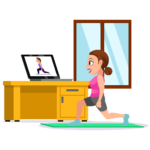Today I wanted to share some practical exercises I give to many clients who come in with all sorts of issues from knee soreness to lower back pain. As many of my readers know, I am a very big proponent of gluteal strengthening for many lower body issues. In fact, I would go as far as to say that if I could only give one exercise to all my patients, it would most likely be something that targets the gluteal muscle group. This muscle group consists of the gluteus maximus, minimus and medius. All 3 of these muscles have different, yet very integrated roles in lower body stability and mobility.
Become an Expert in Managing Gluteal Tendinopathy
The gluteal muscles as a whole are responsible for:
- Hip extension
- Hip abduction
- Hip external rotation and internal rotation
- Raising the body up from a forwardly displaced position (think deadlift)
- Lifting the body out of the stooped position (think squat)
- Femoral, patellar and tibial alignment (knee pain? check the butt!)
- Stabilizing the lower back and sacroiliac joint via its attachment into the thoracolumbar fascia (Back pain? check the butt!)
- Keeps the pelvis level for walking and running
….This can get to be a pretty exhaustive list!
The following is a great quote from fitness expert Mike Boyle that perfectly explains why the gluteal muscles are so important and how their function can become “lost”:
“The truth is that glutes are essential to survival. Low back pain expert Professor Stuart McGill , author of Low Back Disorders, describes the loss of glute strength and size as gluteal amnesia and goes on to implicate lack of strength in the glutes for the debilitating back pain that afflicts so many. The cure for gluteal amnesia is an addanasstomy. The truth is we sit too much, we take too many elevators, we skip too many stairs. The result…Loss of glute function and the relative disappearance of the bodies most vital muscle. Then to top it off we go to the gym and do what? Of course, we work on our upper body. No wonder everyone’s back hurts.
In clinical practice, I have found it hard to get some people to actually understand how to contract their glutes without substituting with other muscles (mainly the hamstrings). I think many reading this blog post can relate when I say that teaching activation exercises can be a frustrating process when the trainee, who usually sits 5-7 hours/day at work, can’t contract the right muscles given the appropriate cues. The good news is that I have found the following exercises to be very helpful in getting my clients to “feel” the right muscle working so we can get them doing higher level activities without as big of a risk of injury or muscle imbalance.
Hip flexor stretch
As I state in the video, it maybe of little use to try and strengthen the butt if the client is sitting in excessive anterior pelvic tilt with tight hip flexors. This “lower crossed syndrome” type of client needs to get more optimal pelvic alignment before we can hammer away at glute activation drills….they won’t be able to do it. There may also be some reciprocal inhibition happening when you stretch the hip flexors to get more gluteal activation…might be a reason to explain how stretching the hips almost automatically helps some clients activate their glutes.
Prone Figure 4 Leg Lifts
Do you have patients who complain of hamstring tightness or spasm even with a simple glute bridge? If so, try this exercise first and the see how their bridge improves! Only caveat here is that the client has to have enough hip ROM to get into the right position
Fire Hydrants to Monster Walks
Great exercises to get the glute medius to fire and to teach the patient what it feels like to use these muscles.
Hip Thrust
This is an exercise I give to many clients as it works better than a bridge to isolate the glute max muscle for the reasons I state in the video. When doing this exercise, make sure the client doesn’t substitute lumbar extension for hip extension…they have to be ‘ready’ to do this exercise.
So there you have it. Some of my go-to exercises to target many common issues I see daily in the clinic. What do you use to target the glutes? How do get those challenging patients to turn on their glute muscles?
 Gluteal tendinopathy is a moderate to severe disabling condition affecting both athletes and sedentary individuals. Up to 1 in 4 females over the age of 50 years can experience symptoms of gluteal tendinopathy. Treatment of this condition should include detailed advice and education as well exercises that include targeted hip muscle strengthening, functional retraining, and dynamic control of adduction during function. This course will cover the results from a recent gluteal tendinopathy study, pathoanatomy, clinical presentation, examination, load management, patient education and exercise for gluteal tendinopathy.
Gluteal tendinopathy is a moderate to severe disabling condition affecting both athletes and sedentary individuals. Up to 1 in 4 females over the age of 50 years can experience symptoms of gluteal tendinopathy. Treatment of this condition should include detailed advice and education as well exercises that include targeted hip muscle strengthening, functional retraining, and dynamic control of adduction during function. This course will cover the results from a recent gluteal tendinopathy study, pathoanatomy, clinical presentation, examination, load management, patient education and exercise for gluteal tendinopathy.